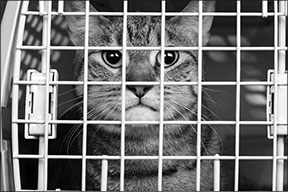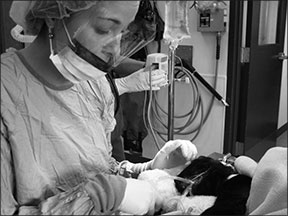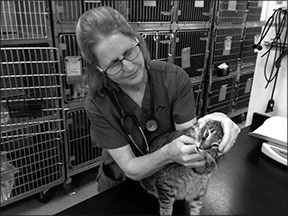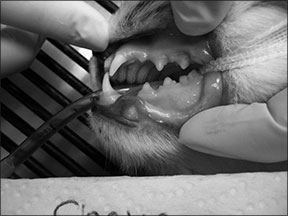If you visit an animal shelter to adopt a cat, you may be surprised to learn that some animals have received dental treatment. In a new and growing movement among shelters, veterinarians and supervised technicians are cleaning teeth, extracting fractured ones and treating inflammation of the gums to boost cats’ chances of winning permanent homes.

288
“We’ve found that dental issues in middle-aged or older cats can interfere with their ability to be adopted due to the costs imparted to the new owner in correcting those problems,” says Elizabeth A. Berliner, DVM, ABVP, the Janet L. Swanson Director of Maddie’s Shelter Medicine Program at Cornell University College of Veterinary Medicine.
Beyond Spaying. “For decades, the focus of shelter medicine has been to address low-cost ways to spay and neuter and contend with overpopulation,” she says. “We have worked hard to develop high-quality, high-volume techniques to enable us to spay and neuter safely and quickly.”
Dental treatment is the new challenge. “Periodontal disease contributes to infection, illness and discomfort in our companion animals,” Dr. Berliner says. “Equipment is expensive and dental procedures can take hours. By having veterinary dentists and shelter veterinarians working together, we know that dentistry could be the ticket to getting homes for more shelter animals.”
At this point, dental procedures are limited at shelters and are usually performed by shelter or general practice veterinarians and their technicians due to the costs. “Most shelters are unable to utilize specialists for this work, as there are few, if any, in many communities, and they can be cost prohibitive,” Dr. Berliner says. “A shelter animal is more likely to have a diseased tooth extracted than to have endodontic work done.”

288
Progressive shelters are seeking grants and donations, and conducting creative fundraisers to provide dental care. Pawsitively Cats in Tucson, Ariz., is staging a Jeep Raffle Cat Dental Benefit. Cause 4 Paws Feline Rescue in Quebec, Canada, raised $576 to provide much-needed dental treatment for a rescue cat, now healthy and up for adoption. And in Brighton, Mass., the Gifford Cat Shelter encourages supporters to designate how their donations are spent, including $500 to cover dental surgery for a shelter cat suffering from painful dental disease.
Staff Training. Veterinarians are donating time and expertise to the movement. Earlier this year, veterinary dentist Tony Woodwood, DVM, AVDC, at Animal Dental Care and Oral Surgery, presented a free, two-day training session for 16 shelter personnel at his dental training center in Colorado Springs. “I did a similar training event for the Toronto Humane Society 18 months ago, and they reported decreased return rates on adoption on those patients who had their mouths cleaned before adoption,” he says.

288
The Humane Society of Boulder Valley, Colo., which cares for 9,000 animals annually, with a 93 percent success rate of adopting or reuniting them with owners, is one of the pioneers in shelter dental care.
“We realized for many years that dental disease can be a strong deterrent to adoption or create problems post-adoption when the adopter takes their new pet to the veterinarian for an exam and walks out with a $1,000-plus estimate,” says Chief Veterinarian Lesli Groshong, DVM. “Nobody wins and the pet may continue to be in oral pain. The pet is unlikely to have the procedure done and may be returned to the shelter where it is likely to be euthanized.”
Preliminary reports from Boulder indicate 70 cats and 60 dogs had major dental procedures there last year and about 75 had simple extractions, Dr. Groshong says. “Not included are animals that were adopted and then had the dental done — usually because there can be a long wait before a dental can be done, so we frequently allow the adoption to be completed and then the pet returns to our public practice for the dental as an owned animal with the shelter covering the cost.” (The nonprofit society operates a public veterinary practice that helps support its work.)

247
Medical Disclosures. The typical dental problems she sees in cats are heavy buildup of tartar and painful absorptive lesions. Animals with tartar and/or gingivitis (gum inflammation) but no painful, abscessed or mobile teeth get a medical disclosure accompanying their adoption stating the pet has dental disease that will likely need treatment from their veterinarian.
The shelter’s board of directors pressed for “zero euthanasia of adoptable animals” about 15 year ago, Dr. Groshong says. “We were beginning to place more older but otherwise healthy animals for adoption and [were] hearing from adopters about the high cost of dental care. We had a simple dental scaler and I began to extract more and more teeth.”
She took Dr. Woodward’s continuing education dental course a decade ago to improve her speed and efficiency in extractions. A veterinarian or certified veterinary technician spends two hours or more on a dental procedure, Dr. Groshong says. “In that time, 12 to 14 spay/neuter surgeries could be completed, and the veterinarian could perform a dozen complete physical exams and enter medical notes. The time and expense of performing dentals is a huge burden on shelters.”

288
The clinic manages its staff to treat three or four animals requiring major dental care weekly, Dr. Groshong says. The sad truth at Boulder and many of shelters across the country: “If we didn’t have the resources to perform dental procedures on the dogs and cats with severe dental disease, they would be euthanized rather than allowing a chronic painful condition to go untreated. Because of the expense of dentistries, it is rare to find people who are willing to adopt animals with severe dental disease even if intervention will be curative.” ❖


